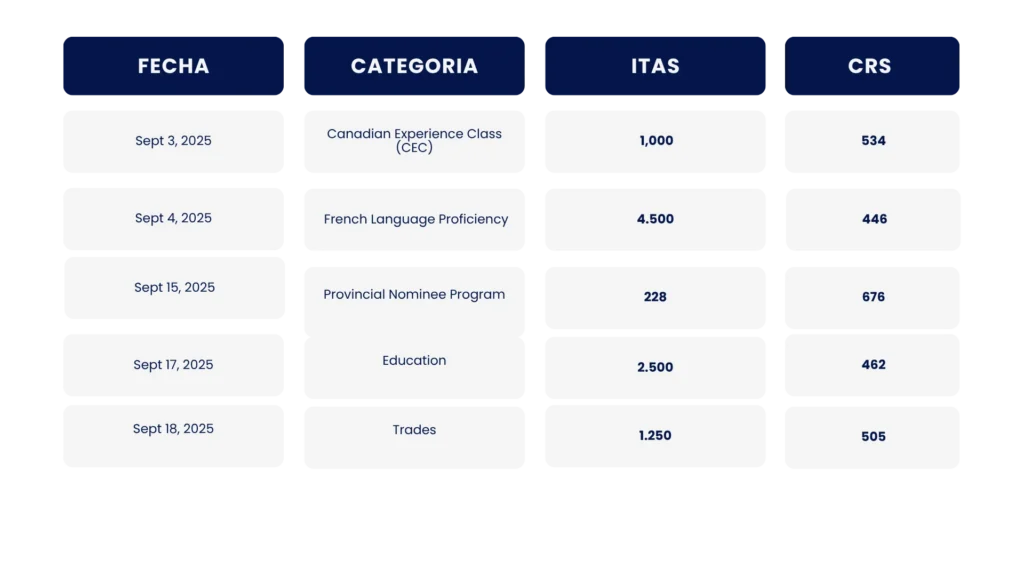Here’s a summary of the most relevant immigration updates from this month in Canada.
If you’re currently in process or considering immigrating, now is the time to stay very attentive.
Here are the news stories that shaped September in Canada:
1. Canada’s population growth slows down
Between April and July 2025, Canada reported one of its slowest population growth rates in decades. Fewer temporary residents arriving and a negative natural growth rate (more deaths than births) explain this slowdown.
This situation is pushing the government to adjust its immigration policies to better align population growth with the country’s capacity.
2. Reforms to the Temporary Foreign Worker Program (TFWP)
Prime Minister Carney announced major changes:
- Moratoriums for low-wage employers: LMIA processing suspended in regions with unemployment rates at or above 6%.
- More frequent inspections and stricter penalties.
- Limits on temporary worker ratios within companies: a cap of 10%–20% depending on the industry.
- Restrictions on open work permits for spouses, with new requirements related to the main applicant’s job offer level and duration.
The stated goal is to prevent abuse and prioritize local employment — though it could also reduce opportunities for foreign workers if not implemented carefully.
3. New rule for employers applying for an LMIA
Employers must now advertise job vacancies for at least four (4) weeks on Job Bank before submitting an LMIA application.
They must also use at least two additional recruitment methods.
The intention is to ensure that employers make genuine efforts to hire Canadians or permanent residents before turning to foreign labor.
The maximum cap on temporary foreign workers per company has also been reduced to 10% for most industries (20% for a few specific sectors).
This represents a reduction from the previous 30% limit, which had remained in place since the pandemic.
Employers who fail to comply may face penalties.
4. Express Entry: more competition and category-based draws
During September, Canada held multiple Express Entry draws focused on specific categories aligned with labor market needs.

The Education draw stood out with a notably lower cut-off score of 462 CRS, a significant drop compared to previous rounds.
The Trades draw required 505 CRS and issued 1,250 invitations.
Overall, Canada continues prioritizing targeted selections by category and skill over general rounds.
Minimum CRS scores remain high, except in certain categories such as French and Education, which fluctuate based on labor demand.
5. CILA sues the federal government
The Canadian Immigration Lawyers Association (CILA) filed a lawsuit against IRCC, ESDC, and Public Safety Canada, arguing that they fail to formally recognize lawyers representing newcomers.
According to CILA, this violates the right to counsel and causes unnecessary delays, costs, and errors. This case could redefine how immigration processes are managed in the future.
6. Asylum claims: more returns and unfounded cases
In the first eight months of 2025, Canada returned over 3,200 people to the U.S. under the Safe Third Country Agreement.
Human rights advocates warn that some of these individuals could face persecution or unsafe conditions upon return, reigniting debates around justice and compassion in Canada’s asylum system.
At the same time, official data from the Refugee Protection Division (RPD) shows a record number of unfounded or false claims.
In just the first half of 2025, over 3,200 asylum claims were rejected for lacking merit or containing false information nearly matching the 5,000 rejected during all of 2024.
This contrast highlights growing pressure on the asylum system, which must balance genuine protection needs with a rising number of fraudulent or baseless claims that delay processing for those truly in need.
7. The “Strong Borders Act” under discussion”
Parliament is debating the proposed Strong Borders Act, aimed at tightening border control and limiting asylum access for those entering irregularly or delaying registration.
Critics fear it could leave many individuals without access to hearings or legal recourse.
8. Higher financial requirements for international students
As of September 1, 2025, international students must show higher proof of funds to qualify for study permits.
While this seeks to ensure financial stability during their stay, it may make studying in Canada less accessible for many aspiring students.
In summary
September was a month full of significant immigration updates for Canada — selective Express Entry draws, temporary worker reforms, new employer rules, and legal actions that could reshape the immigration landscape.
The trend points toward a more strategic and selective immigration model, though it raises concerns about those struggling to meet the increasingly high CRS thresholds.






